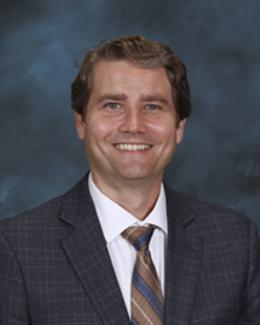March 6, 2017 — Not everyone can look back on their life and pick the specific instance that brought them to their current field and dictated the course of their career. For Jason Newby, that instance was a high school physics class that would eventually lead to him studying nuclear technology and investigating unknown corners of particle physics.
Newby was a member of the mock trial and debate teams and planned to pursue law or political science in college. He didn’t even know it was possible to make a living as a scientist.
That all changed in his senior year when he took an AP physics course taught by Mrs. McNeil, who showed him the power of fundamental science and the endless applications of physics in the real world.
“There’s no substitute for that first physics teacher,” Newby said. “I think a lot of people have an experience with physics that is horrible and what makes it or breaks it is the teacher. Mrs. McNeil presented it in a way that made it fun and exciting and set the course for me.”
Newby became fascinated with the complex invisible machinery of the physical world and would eventually earn his doctorate in physics from The University of Tennessee before joining the physics division at Lawrence Livermore National Laboratory. While visiting UT, Newby heard ORNL Director Thom Mason deliver the introductory welcome speech at a collider physics conference.
“He said the lab would hire lots of new researchers in the coming years and I thought, ‘I think I want to be one of them,’” Newby said. “Within maybe two months, I’d found a way to work my way back here.”
Newby is now a physicist in the Nuclear Security and Isotope Technology Division at the Department of Energy’s Oak Ridge National Laboratory.
As a researcher in the Nuclear Material Detection and Characterization group, Newby works on detector technology capable of imaging the fast neutrons emanating from highly enriched uranium or plutonium in nuclear weapon systems. The detector can reliably visualize fissile nuclear material and may assist with nuclear arms negotiations and treaty verifications in the future.
Newby values both basic and applied research and likes to shift his thinking between real world applications and big picture ideas. One of the more important qualities for a scientist to have, he said, is a pioneering spirit that drives you to venture beyond the boundaries of traditional research.
“When we’re studying the universe, sometimes in the laboratory and sometimes looking out beyond our planet, there’s some sense of exploration there,” he said. “I still love the fact that we explore just to know more about the universe we live in and to appreciate the beauty of the way the whole system works.”
That sense of exploration is strong at ORNL, and Newby appreciates the lab’s ability to pursue small ideas and develop them into world-class programs over time.
“Part of the role of a national lab is to chase the things that are high risk with big societal benefits that we know don’t necessarily have a near-term payoff,” Newby said. “You need a high failure rate in order to find those things that are the riskiest but maybe the most rewarding.”
One of these long-term, leading-edge research efforts is ORNL’s neutrino detection program, which Newby has been involved with from its earliest stages. He and other physicists recognized the potential applications of the lab’s neutron facilities for neutrino research, so they devised a plan to promote, fund and eventually build the program from the ground up.
“I remember having the sense that if the people at the lab knew the possibilities of what we could do, then they would be on board with it,” Newby said. “I think it was a really gratifying part of the process to have undertaken, just to have a vision, to realize the pieces are there.”
Newby is a member of the COHERENT team, a Duke University-led experiment to observe coherent scattering of neutrinos emitted by the pulses of the Spallation Neutron Source, a DOE Office of Science User Facility.
The project uses banks of heavily-shielded detectors in the SNS basement to filter out cosmic background neutrons and focus on the sharply pulsed beams to find a neutrino signal. The team hopes to measure low-energy neutrinos for the first time via coherent scattering to test the Standard Model of particle physics and answer questions of nuclear structure.
Newby is confident about the project and thinks it will produce positive results as the technology improves. The hope, he said, is that the effort put into the project provides significant insight into the behavior of neutrinos and leads to a better understanding of fundamental science concepts.
“I think there’s a question as you make a choice about committing to a career in science, wondering whether or not, at the end of the day, you’re going to bring about real change,” Newby said. “I think my fundamental goal is just to know that I’m making a really valuable contribution and discovering the nature of the universe we live in.”
UT-Battelle manages ORNL for the DOE's Office of Science. The Office of Science is the single largest supporter of basic research in the physical sciences in the United States, and is working to address some of the most pressing challenges of our time. For more information, please visit https://energy.gov/science.



